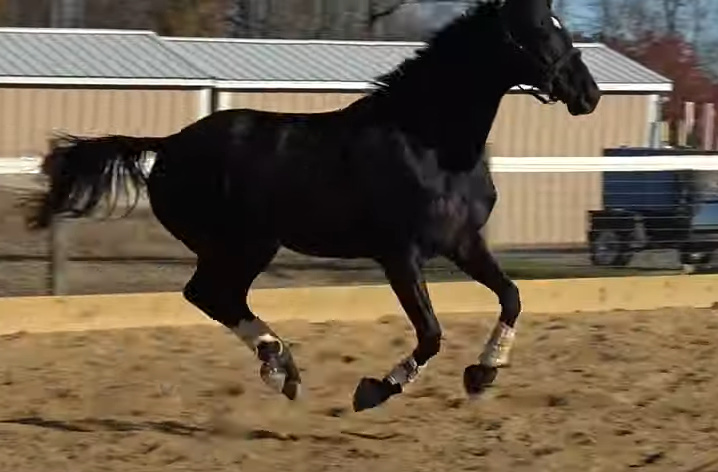General back issues and KS have a “shape” to it versus one specific trigger or tell. There’s a lack of harmony to the picture. When he is asked to move out or forward the first thing that happens is the neck tenses and is unnaturally held. His head carriage is inverted. The neck acts as rudder, there are a few parts where he is stabilizing his trailing and weak hind end by propping up his neck and shoulder.
Any time I see neck go UP UP inverted and hocks go OUT and trail behind, I suspect sore back. Can be any number of things causing it, but that “outline” in of itself is so textbook to back pain.
Watch the tail. It’s held away from his body at almost all times, especially when he is required to move forward or change direction. It gets clamped to the side a few times. His whole back looks like a stiff board held as flat as possible. His canter is crooked with poor separation of the hinds, watch how his hocks snap under his buttocks but never seem to extend underneath his body in a fluid forward stride - this is a good example of him mid-canter stride, the hind end should have more separation and instead the hind end is moving almost paired:
Around turns he stiffens and inverts his whole body. The hind ends tend to pair together versus be separated and push from the ground - there is no clear rhythm or balance. The hocks and stifles are stiff, the hocks trail out behind him. The whole hind end ROM lacks harmony.
I notice KS horses tend to have abnormal ROM with their fetlock during loading phase at canter. They drag their toes and never really fully flex that limb down. It’s like they are moving off of that hoof as soon as possible.
This whole outline is what I mean - no separation of hinds and a flat back:

At that phase of his stride his head should be lower, hocks should be bent, not straight out behind him, and the croup should be lifting up to allow the hind end to come back under the body. The stifle and hock don’t really fully articulate, and the limb looks like it is stabbing up and down.
In the ridden videos what sticks out to me the most is how reactive he is in the canter and the inconsistent lameness behind at trot. All that tail wringing and butt-propping, head tossing, and how a few times at the trot you see his hind end is taking a “half step” as if about to canter, but not. Going faster and faster until you collapse into a stilted canter is kissing spine modus operandi. Ears back, tail held like a pointer dog when not being whipped around, teeth exposed, toe dragging, stabby motion behind, all contribute an overall shape that presents as physical pain.


 but then I see that he isn’t tracking up behind at trot, which I associate with hock issues. The canter is upright and short, but sometimes that happens in a smaller pen where the horse doesn’t feel he can move freely enough. It’s a really interesting case study to get the sales video and the diagnosis/prognosis because we end up seeing so many videos asking “is this horse sound?” we all reply NQR, poster doesn’t buy horse and end of story.
but then I see that he isn’t tracking up behind at trot, which I associate with hock issues. The canter is upright and short, but sometimes that happens in a smaller pen where the horse doesn’t feel he can move freely enough. It’s a really interesting case study to get the sales video and the diagnosis/prognosis because we end up seeing so many videos asking “is this horse sound?” we all reply NQR, poster doesn’t buy horse and end of story.
